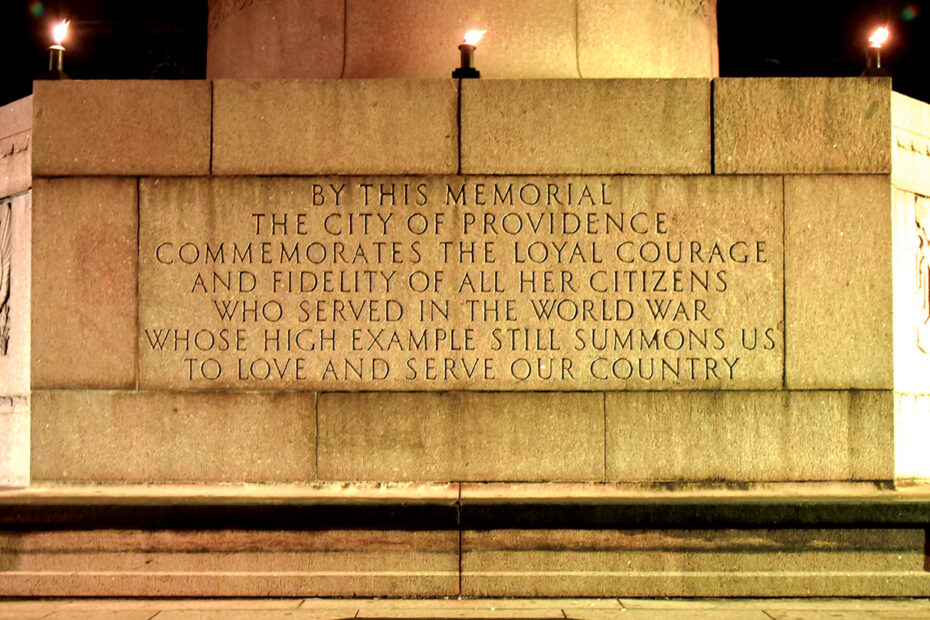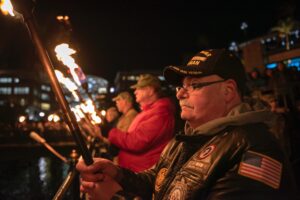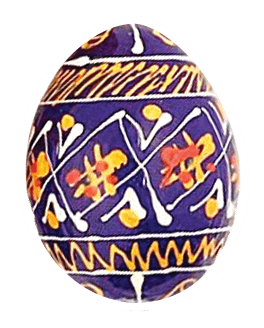Memorial Park pays homage to Rhode Islanders who gave their lives during wars and conflicts around the world. For all full WaterFire lightings the park is one end (or beginning!) of our footprint. It has become a reflective place for visitors and locals alike. The light of luminaria candle lanterns lead you along the winding paths towards several memorials. Everyone is welcome to be a part of the night by dedicating a luminaria and sharing their light with the world.
During the WaterFire Salute to Veterans Lighting the memorials will shine bright for everyone to visit and reflect.
Learn more about the memorials in the park:

The World War II Memorial was built to honor the 96,000 Rhode Islanders who served in WWII. Each of the 8 granite columns is inscribed with the names of the major battles and campaigns of WWII on their inner face. The monument itself is surrounded by a granite walkway and a retaining wall, engraved with the seals of each of Rhode Island’s 39 cities and towns.
Four contemplation benches flank the entrance in front of the honor roll walls inscribed with the names of the 2,560 war casualties of Rhode Island service men and women. Each of these benches highlight one of the four freedoms outlined in President Franklin Delano Roosevelt’s State of the Union Address, commonly known as the Four Freedoms speech, given on January 6, 1941: “Freedom of speech, freedom of worship, freedom from want and freedom from fear.”

The Great War (World War I) Memorial, reaches up towards the sky nearby the intersection of College and South Main Streets. The memorial was built to honor the more than 700 Rhode Islanders who died in the First World War. The granite memorial, designed by architect Paul Cret, was erected in 1929 and stands 150 feet high.
The platform below the granite central pillar contains four bronze plaques, depicting a battleship, airplane, tank, and machine gun. The plinth has four large faces separated by military branch insignias. The faces of the platform are also inscribed with the city’s dedication of the monument and quotations by Abraham Lincoln, Woodrow Wilson, and Ralph Waldo Emerson. The lower portion of the column contains a memorial frieze that symbolizes the virtues of Providence’s citizens during the war, and above the frieze are the major battles in which Rhode Islanders fought. A band of stars surrounds the top of the fluted pillar; together, they represent the stars and stripes. The heroic figure of peace stands atop the pillar.
During most full WaterFire lightings you can find the living statues of Ten31 Productions performing alongside the pillar by the glow of torches.

The Rhode Island Nine Beirut Memorial. Nine marines from Rhode Island lost their lives in a 1983 terrorist attack on a Marine compound in Beirut. The nine Marines were among 241 American service personnel that perished in the attack. The memorial is located at Remembrance Park along the Providence River.
The names of the fallen Rhode Island Marines are Sgt. Timothy Giblin of North Providence; Lance Cpl. Thomas Julian of Portsmouth; Cpl. James Silvia of Middletown; Cpl. Stephen Spencer of Portsmouth; Cpl. David Massa of Warren; Cpl. Edward Soares, Jr. of Tiverton; Cpl. Rick Crudale of West Warwick; Cpl. Edward Iacovino, Jr. of Warwick; and Cpl. Thomas Shipp of Woonsocket.

The Korean War Memorial was erected in 1995 to express the everlasting gratitude of the people of Rhode Island to the men and women of our country who served in the Korean War. The memorial was designed to represent the spirit of service, the willingness to sacrifice and the dedication to the cause of freedom that characterized all of the participants. The Korean War Monument and Memorial Walkway in Providence’s Memorial Park was dedicated on October 8, 1995, in honor and tribute to the 39,000 Rhode Islanders who served our country during the conflict.
The center of the memorial is a bronze sculpture of a soldier depicted by the renowned artist Robert Shure as being on guard, isolated and alone, but not forgotten. His hands hold his rifle intensely while his head is down against the cold and biting wind, yet his eyes are staring into the distance. He exemplifies the fact that freedom is not free.
The white bricks in the Memorial Walkway are engraved with the names of the 145 Rhode Islanders who were killed in action and the 55 Rhode Islanders still listed as missing in action. The red bricks in the walkway are engraved with the names of veterans who have been remembered by their friends or families.
Beyond Memorial Park at the WaterFire Salute to Veterans Event

On the confluence, where the rivers meet, there will be a Missing Man Table set up to honor the memory of fallen, missing or imprisoned military service members. Every piece of this touching memorial has a special meaning, and we invite you to join us in taking a moment to think about our soldiers that are no longer with us or are missing.
The table is round: showing our everlasting concern for our men and women still missing. The tablecloth is white: The cloth symbolizes the purity of their motives when answering the call to duty. The napkin is black: Symbolizing the “dark hearts of some politicians” and other leaders in government who haven’t tried to bring our soldiers home and who have forgotten them… A single red rose, is displayed in a vase: The red rose reminds us of the life of each of the missing, and of their loved ones and close friends who keep the faith and await answers concerning their missing family member or friend. The vase is tied with two ribbons: The red ribbon represents the red ribbons worn on the lapels of the thousands who demand, with unyielding determination, a proper accounting of our comrades who are not and the yellow ribbon reminds us of the family and friends of our missing among us comrades who keep faith awaiting their return. A slice of lemon on the bread plate: reminds us of the bitter fate of those captured and missing in a foreign land. A pinch of salt on the bread plate: symbolizes the tears endured by those missing and their families who seek answers. An inverted glass can be seen at the place setting: The inverted glass symbolizes the POW/or MIA’s inability to share in this evening’s meal. The empty chair represents the missing and fallen who aren’t present. The candle is reminiscent of the Light of Hope: which lives in our hearts to illuminate their way home, away from their captors, to the open arms of a grateful nation.
Learn more about WaterFire’s Salute to Veterans event here.
About the author
Over the last 10+ years, alongside some incredible co-workers and volunteers, I've worked to build the organization that WaterFire Providence is today. As Director of Creative Services, my team and I work on visual communications, graphic design, the visitor experience, merchandising as well as project management for programming at the WaterFire Arts Center. Being a part of the 'Rhode Island' experience for tens of thousands of people is incredible and I have an intense pride in place for both Downtown Providence and the Valley neighborhood.






















